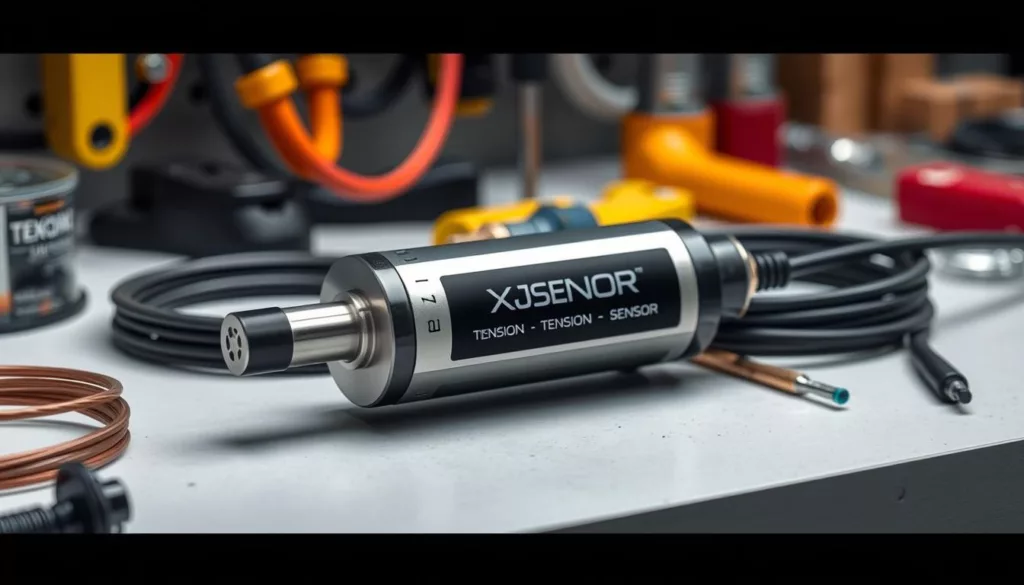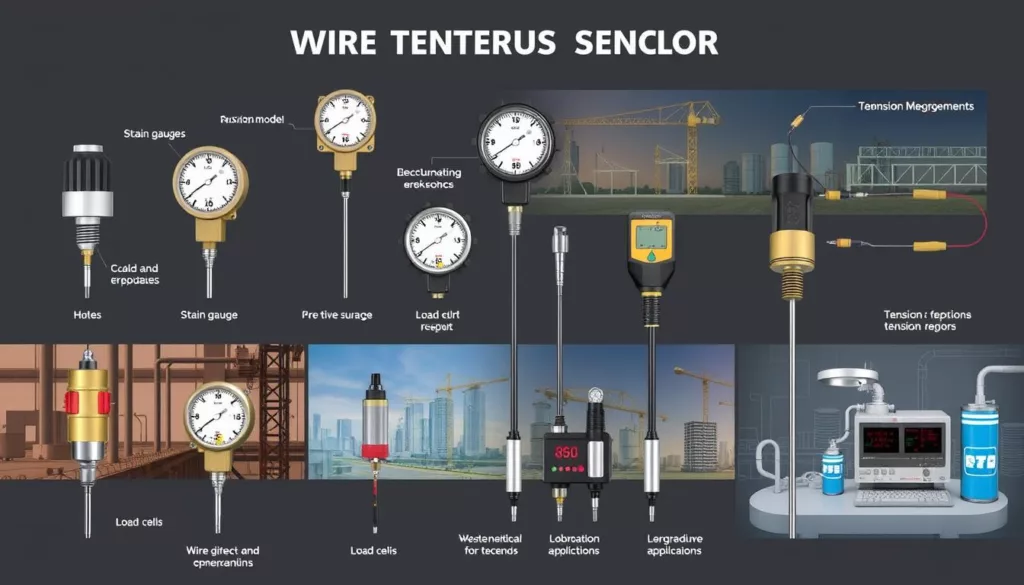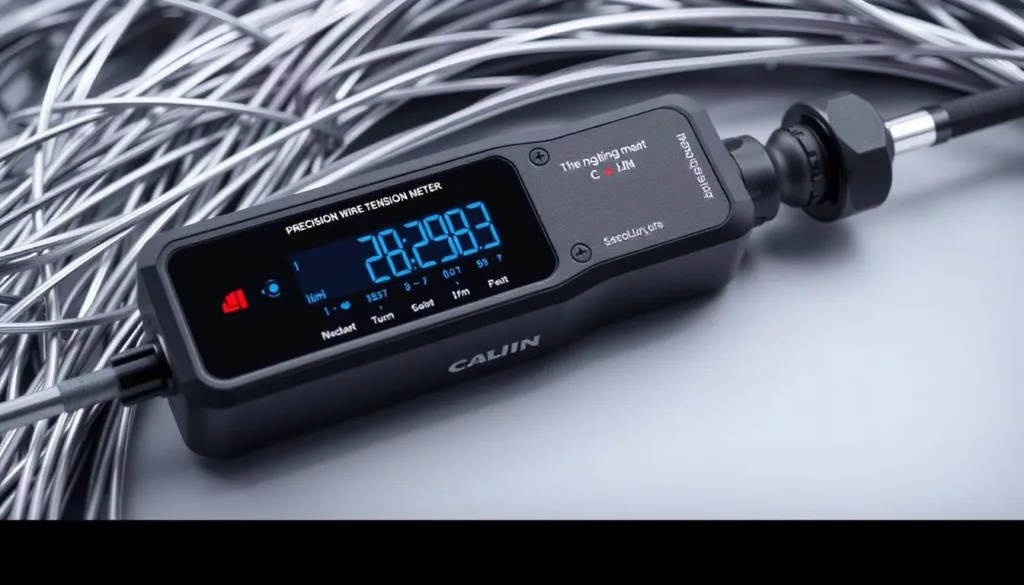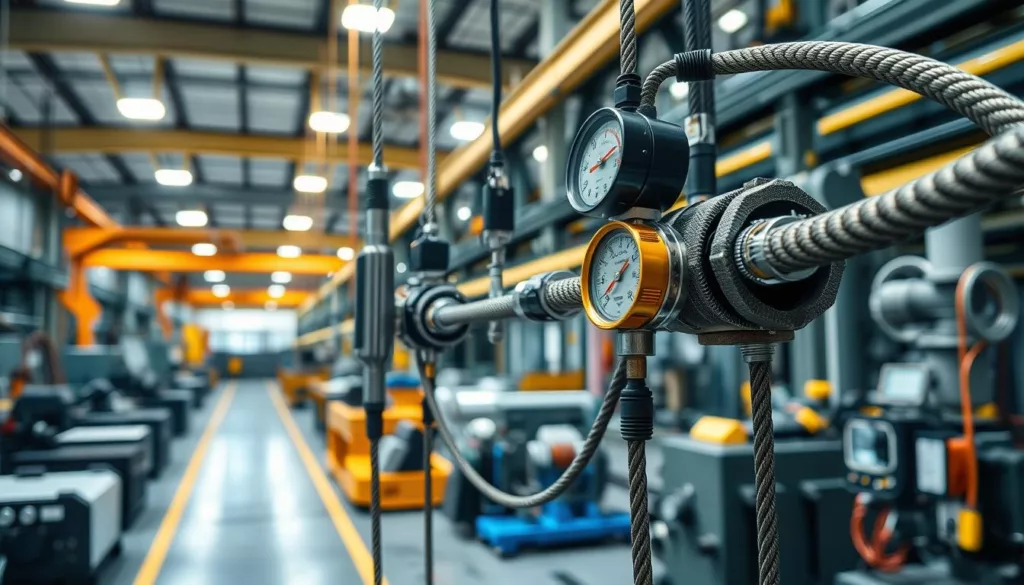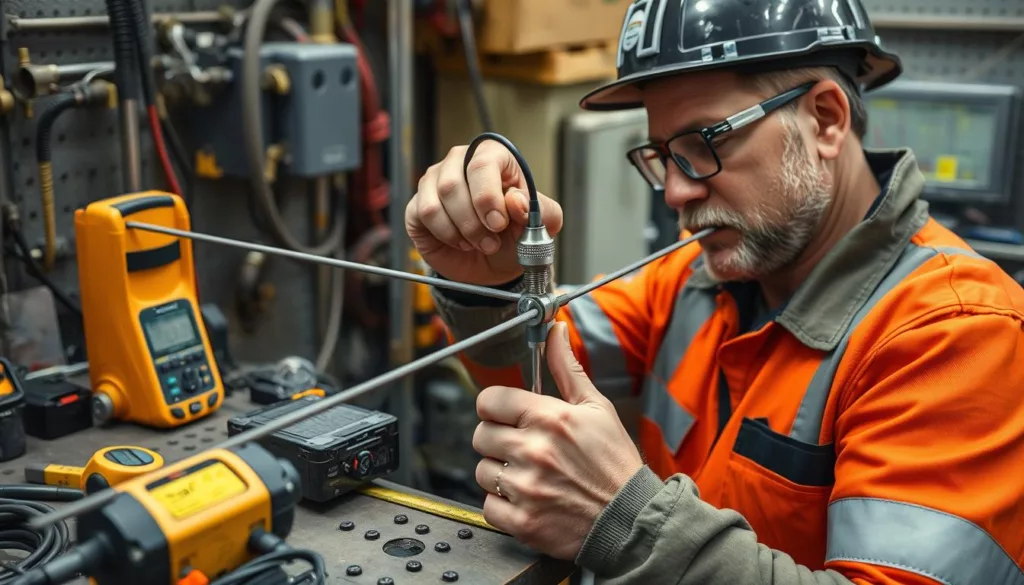Measuring wire tension accurately is key in many fields like construction, manufacturing, and aerospace. With technology improving, the need for precise tension sensors has grown. This guide will cover the top tension sensors for wire tension, explaining how they work and what to look for.
Measuring wire tension is vital for many critical tasks. It ensures the safety and performance of products and systems. Whether it’s for bridges, wiring, or machinery, the right tension sensor is essential.
Key Takeaways
- Understand the fundamental principles of wire tension detection and measurement
- Explore the top tension sensor solutions for accurate wire tension measurement
- Discover the key features and capabilities to look for in a wire tension sensor
- Learn about the various applications and use cases for wire tension sensors
- Gain insights into the importance of precision and accuracy in tension measurement
Understanding Wire Tension Measurement Fundamentals
Measuring wire tension accurately is key in many industries. This includes construction, transportation, mining, and manufacturing. Cable tension transducers, wire force sensors, and load cell sensors for wires are at the core. They help monitor wire tension levels in real-time with great precision.
Basic Principles of Wire Tension Detection
The basic idea behind measuring wire tension is simple. It’s about how force changes the wire’s shape or strain. Sensors use this to figure out the tension on a wire. This info is vital for improving processes and keeping things safe.
Why Accurate Tension Measurement Matters
- It makes sure wire systems work well and last long.
- It spots problems like sagging, breakage, or too much load.
- It helps with early maintenance and prevention.
- It boosts safety and reliability in operations that rely on wires.
Key Components of Tension Sensing Systems
Good wire tension measurement needs a few key parts. These include:
- Tension sensors (like cable tension transducers, wire force sensors, load cell sensors for wires)
- Systems for gathering and handling data
- Tools for showing and controlling data
- Rules for keeping everything calibrated and maintained
“Precise wire tension monitoring is key for keeping industrial systems safe and working right.”
Best Tension Sensor for Wire Tension Measurement: Top Picks
Choosing the right string tension measuring devices is key for accurate wire tension monitoring. Our experts have reviewed and compared top tension sensor models. They’ve picked the best for different wire tension measurement needs.
The XJCSENSOR TS series is a top choice. These durable and reliable tension sensors use advanced strain gauge technology. They offer high accuracy and can be easily installed. The TS series is great for many uses, from cable making to mining.
| Sensor Model | Measurement Range | Accuracy | Overload Capacity |
|---|---|---|---|
| XJCSENSOR TS-100 | 0-100 kN | ±0.5% FSO | 150% of Rated Load |
| XJCSENSOR TS-500 | 0-500 kN | ±0.5% FSO | 150% of Rated Load |
| XJCSENSOR TS-1000 | 0-1000 kN | ±0.5% FSO | 150% of Rated Load |
The XJCSENSOR CTS series is perfect for cable tension monitoring. These sensors use piezoelectric technology for real-time measurements. They are accurate and reliable.
For managing wire tension in manufacturing, construction, or mining, XJCSENSOR’s top sensors are ideal. They offer precision and reliability. By choosing XJCSENSOR, you get customized, high-quality sensors and expert support.
Types of Wire Tension Sensors and Their Applications
There are many types of sensors for measuring wire tension. Each has its own strengths for different needs. Let’s look at the main types and what makes them special:
Load Cell-Based Sensors
Load cell-based sensors are known for their high accuracy and reliability. They use strain gauges to turn wire tension into an electrical signal. This makes them perfect for places where keeping tension steady is key, like in cable making, elevator systems, and checking suspension bridges.
Strain Gauge Sensors
Strain gauge sensors are also popular for measuring wire tension. They work by changing their electrical resistance when stretched. These sensors are great for catching small changes in tension, which is important in textile making and checking wire ropes.
Piezoelectric Sensors
Piezoelectric sensors use the piezoelectric effect to send an electrical signal based on wire tension. They’re best for measuring tension changes over time, like in machines and industrial settings.
| Sensor Type | Key Advantages | Ideal Applications |
|---|---|---|
| Load Cell-Based | High accuracy, reliability | Cable manufacturing, elevator systems, suspension bridges |
| Strain Gauge | Excellent sensitivity, precision | Textile production, wire rope inspection |
| Piezoelectric | Dynamic measurement capabilities | Vibration analysis, impact force detection |
Knowing about these sensors helps you pick the right one for your needs. This ensures your industrial processes run smoothly and efficiently.
Precision and Accuracy Features in Modern Wire Tensionmeters
The latest in sensor technology has changed the game for wire tension measurement. Wire tension meters now offer top-notch precision and accuracy. This means reliable readings for a wide range of industrial uses. These advanced tools use new features to give consistent, high-quality results. This helps professionals make better decisions with confidence.
Advanced digital processing algorithms are a big part of this improvement. Best tension sensors for wire tension measurement use smart signal processing. This reduces noise, improves linearity, and boosts stability, even in tough conditions. Thanks to this, some models can measure with a resolution as fine as 0.1% of the full-scale range.
| Feature | Benefit |
|---|---|
| High Accuracy | Reliable readings within 0.1% of the full-scale range |
| Exceptional Linearity | Consistent performance across the measurement spectrum |
| Advanced Digital Processing | Enhanced noise reduction and signal stability |
| Robust Construction | Durable design for use in demanding industrial settings |
Modern wire tension meters also have tough construction and smart mechanical designs. These sensors are built to last in harsh industrial settings. They work well even with vibrations, temperature changes, and other tough conditions.
The newest best tension sensors for wire tension measurement offer precision, accuracy, and durability. They help operators make smart choices, improve production, and boost wire system efficiency. As technology keeps advancing, these advanced tensionmeters lead the way in reliable wire tension monitoring and control.
Cable Tension Monitoring Systems for Industrial Use
In the world of industry, cable tension monitoring is key. These systems are vital for keeping equipment safe, efficient, and running well. This includes cranes, elevators, and production lines.
Real-Time Monitoring Capabilities
Modern systems can show cable tension as it happens. String tension gauges and transducers watch the cables. They send this info to a main control system.
Data Logging and Analysis Features
These systems don’t just show real-time data. They also log and analyze it. This helps operators see trends, spot problems, and improve system performance over time.
Integration with Industrial Control Systems
Many systems work well with industrial control systems. This makes operations smoother and more efficient. It also helps prevent equipment failures and keeps things running smoothly.
Using advanced cable tension monitoring systems can really help industries. It makes operations safer, more productive, and more efficient. This leads to better profits and a strong market position.
Installation and Calibration Guidelines
Getting your wire force sensors and load cell sensors to work right needs the right setup and calibration. At XJCSENSOR, we guide you step by step. This helps you get the best out of your sensors in your work.
Sensor Placement and Mounting
Where you put your sensors is key for good tension readings. Here are some tips for installing your wire tension sensors:
- Find the best spot on the wire for your sensor.
- Make sure the sensor is straight and clear of any blockages.
- Use the right hardware to mount the sensor, as the maker says.
- Don’t put the sensor near things that might mess with its reading, like vibrations or electromagnetic fields.
Sensor Calibration and Adjustment
Calibration is vital for precise tension readings. Here’s how to calibrate your sensors:
- Use a known load to test the wire, with a trusted device.
- Adjust the sensor to match the load, as the maker’s guide says.
- Check the sensor’s accuracy with different loads and see how it does.
- If needed, calibrate again until the sensor’s readings are just right.
Follow these steps for installation and calibration. This way, your wire force sensors and load cell sensors will give you accurate tension readings. This will make your industrial processes run better.
Maintaining and Troubleshooting Tension Sensors
Keeping your string tension measuring devices or cable tension monitoring systems working well is key. We’ll look at common problems with tension sensors and how to fix them. This will help your system stay accurate and reliable.
Common Issues and Solutions
One big problem is sensor drift, where the tension reading changes over time. This can happen due to changes in the environment, wear on the sensor, or electrical issues. To solve this, make sure to calibrate your sensors often. Also, think about using sensors that can handle temperature changes.
Sensors can also get damaged or fail. This might be because of physical harm, corrosion, or too much weight. To avoid damage, mount sensors right and follow the maker’s weight limits. If a sensor breaks, replace it fast to keep your tension readings correct.
Maintenance Schedule Best Practices
- Check tension sensors and cables regularly for any damage or wear.
- Calibrate your sensors as the maker suggests, usually every few months or a year.
- Clean the sensor surfaces and ensure they’re grounded to avoid interference.
- Have a plan to replace sensors before they wear out to keep them working well.
Calibration Procedures
Calibration is vital for your devices to stay precise. Here’s how to do it right:
- Take the sensor out of your system and set it up in a calibration rig or machine.
- Apply known tension loads to the sensor and note the readings it gives.
- Compare the sensor’s readings to known tension values and adjust as needed.
- Check the sensor’s accuracy for all tension levels it’s meant to measure.
- Write down the calibration results and plan when to do it again.
By being proactive with maintenance, troubleshooting, and calibration, you can keep your devices running smoothly. This means you’ll get accurate tension readings and your equipment will work its best.
Cost Analysis and ROI Considerations
Investing in high-accuracy wire tension sensors like precision wire tensionmeters is key for top machine performance and productivity. But, it’s vital to look at the financial side of things before making a move. Our experts at XJCSENSOR have done a deep dive into the costs to guide you.
The cost of precision wire tensionmeters and other high-accuracy wire tension sensors can change based on your needs, the sensor tech, and how customized it is. The initial cost might seem high, but the long-term gains of precise tension monitoring are worth it.
Don’t forget about the costs of keeping and calibrating the sensors. Regular upkeep and calibration are key for dependable and steady readings. This boosts your ROI over time.
“Accurate wire tension measurement is key for the best efficiency and life of your machines. The right precision wire tensionmeters can save you a lot of money in the long run.”
By looking at the total cost of owning these sensors, you can make a smart choice. Our team is here to give you clear cost analysis and ROI forecasts. We aim to help you get the best results for your business.
Conclusion
We’ve looked at the top tension sensors for measuring wire tension accurately. We’ve covered load cell, strain gauge, and piezoelectric sensors. Each has its own special features and uses.
Understanding how these sensors work is key. It helps professionals pick the best one for their needs. This ensures precise measurements are made.
XJCSENSOR leads in tension monitoring systems. They give real-time data and advanced analytics. Our sensors work well with industrial controls, making processes better and more efficient.
When choosing a tension sensor, think about what you need. Consider the environment and costs over time. The right best tension sensor for wire tension measurement and wire tension meters can boost your productivity and growth.

